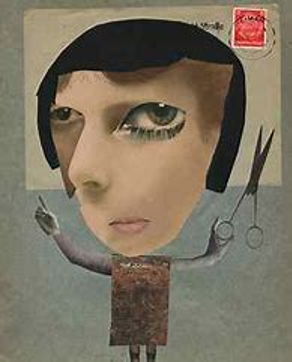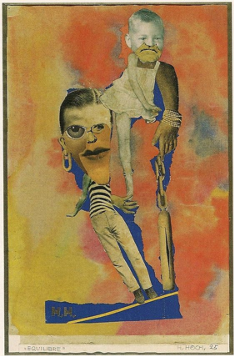Students will observe the concept of visual proportion, learn about Dada artist Hannah Hoch, then create their own out-of-proportion collage. Recommended for 2nd Graders.
Shape: a two-dimensional (flat) area enclosed by a line. Shapes can be geometric or organic.
Contrast: the arrangement of opposite elements, or using very different qualities next to each other to create visual interest, excitement and drama.
Emphasis (focal point): the part of an artwork that is emphasized in some way and attracts the eye and attention of the viewer; also called the center of interest.
Scale/Proportion: the relationship of parts of a single object to the whole.
Unity: the connecting of parts of a work of art, creating a feeling of peace and a sense of completeness. All parts should work together.
Craftsmanship: following directions and using care and neatness with tools.
Dada art style: often nonsensical, developed in Europe as a reaction to the horrors of WW1.
Photomontage: a type of collage in which the pasted items are actual photographs, or photographic reproductions pulled from the press and other widely produced media.
Hannah Höch was a German artist. She was one of the originators of photomontage. She distorted proportions of human figures to make a statement about Germany just before WW2, a difficult time for Europe. Out-of-proportion characters suggested things were ‘out of whack’ in the world.
 Bad Art
Bad Art  Equilibri, 1925
Equilibri, 1925
Pre-cut lots of magazine color photos of people and objects. Also cut larger background type pictures, like rooms, the outdoors, city streets, etc. Don’t trim too closely, let students do that. Include vastly different sizes.
Students will:
Lesson written by Cynthia Moring. Weiner Elementary website Scale and Proportion lesson.
21st Century Thinking Skills
Thinking flexibly, persisting, creating, innovating, taking responsible risks, reflecting, goal setting, observing, making connections, visualizing, predicting, comparing/contrasting, finding evidence, determining Point of View, decision making, evaluating.
WA State Learning Standards
(VA:Cr1.2.2) a. Make art or design with various materials and tools to explore personal interests, questions, and curiosity.
(VA:Cr2.1.2) a. Experiment with various materials and tools to explore personal interests in a work of art or design.
(VA:Cr2.2.2) a. Demonstrate safe procedures for using and cleaning art tools, equipment, and studio spaces.
(VA:Cr2.3.2) a. Repurpose objects to make something new.
(VA:Cr3.1.2) a. Discuss and reflect with peers about choices made in creating artwork. This happens if you share out.
(VA:Re7.1.2) a. Perceive and describe aesthetic characteristics of one’s natural world and constructed environments.
(VA:Re8.1.2) a. Interpret art by identifying the mood suggested by a work of art and describing relevant subject matter and characteristics of form.
(VA:Re9.1.2) a. Use learned art vocabulary to express preferences about artwork.
(VA:Cn10.1.2) a. Create works of art about events in home, school, or community life.
(VA:Cn11.1.2) a. Compare and contrast cultural uses of artwork from different times and places.
Please note: These lesson plans are intended for non-profit use only. Use of these plans for commercial purposes should give attribution to the Issaquah Schools Foundation and be accompanied by a nominal donation at www.isfdn.org/donate. Thank you.
Fueling Success for Every Student, Every School